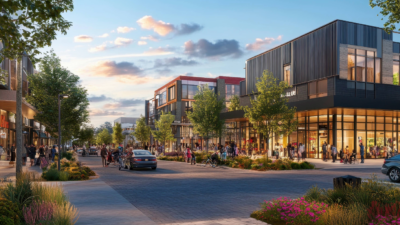2024 marks a pivotal year for both healthcare and healthcare real estate. The industry’s transformation is driven by a combination of factors, including technological breakthroughs, changing patient expectations, and a shift toward proactive health management.
As these trends continue to evolve, healthcare and real estate stakeholders must collaborate to create spaces that not only address immediate needs but also anticipate and adapt to future healthcare dynamics. Looking at the year ahead, several trends are shaping the landscape of the industry.
Demand for Flexible and Adaptive Spaces
The unpredictability of healthcare demand requires flexible real estate solutions. Modular designs, movable walls, and multipurpose spaces are gaining popularity in order to swiftly adapt to changing patient volumes and healthcare services while ensuring optimal utilization of square footage. Recently, M Health Fairview showcased a modular, prebuilt space that accommodates 16 beds for short-stay and observation.
Modular constructions allow for quick transformations, catering to fluctuations and unforeseen crises, such as pandemics. Similarly, medical coworking is on the rise and these spaces provide a flexible alternative to traditional clinical settings, enabling practitioners to rent office or clinical space on demand.
Rise of Ambulatory Surgery Centers
Recent data shows ambulatory surgery centers (ASCs) are predicted to see 22% growth over the next 10 years as healthcare delivery increasingly shifts to outpatient settings. Ambulatory care centers are gaining traction as they offer convenience, cost-effectiveness, and a wide array of outpatient services. In 2024, these centers will be expanding their scope of services to provide more complex procedures that had previously been exclusive to hospitals. The leading services will include rheumatology, gastroenterology, endocrine, and dermatology, per Provista.
Sustainability and Wellness in Real Estate
Sustainability is no longer a secondary consideration in healthcare real estate. Green building practices, energy-efficient designs, and carbon-neutral goals are becoming integral to new construction within health systems, according to findings from PwC. From LEED-certified buildings and renewable energy integration to waste reduction strategies, sustainability objectives align with the healthcare sector’s commitment to overall well-being.
Furthermore, the focus on wellness extends to include the well-being of healthcare professionals. Designing spaces that prioritize ergonomics, mental health support, and work-life balance is crucial. The “humanization” of healthcare settings, through features like wellness rooms, meditation spaces, and nature-inspired designs, is coming into focus to create healing environments beyond traditional clinical settings.
Investment Opportunities and Financial Innovations
The U.S. economy remains lackluster entering 2024, and the investment outlook for many commercial real estate sectors remains challenging due to ongoing inflation and the challenging interest rate environment.
However, assets such as medical outpatient buildings and other healthcare real estate properties continue to attract investors seeking stable, long-term opportunities. Financial innovators such as healthcare Real Estate Investment Trusts (REITs) have gained momentum, providing avenues for diversified investments in healthcare properties. Morgan Stanley is set to launch a REIT focused on healthcare, industrial, and retail properties, primarily holding long-term net-leased assets.
Challenges and Opportunities Ahead
Despite the promising trends, challenges persist. Shrinking margins, rising construction costs, regulatory complexities, and the need to balance technological advancements with patient privacy pose ongoing hurdles. However, these challenges also present opportunities for innovation and adaptation.
Technological integration, patient-centric design, sustainability, and financial innovation pave the way for a future where healthcare spaces not only heal but also adapt and evolve in tandem with progress in the medical arena and societal needs. The synergy between healthcare and real estate continues to shape a landscape that seeks to harmonize the physical infrastructure of healthcare with the evolving needs of patients, practitioners, and investors.

 Shawn Janus
Shawn Janus


 Malcolm Randolph Jr.
Malcolm Randolph Jr.
 Brian Bruggeman
Brian Bruggeman